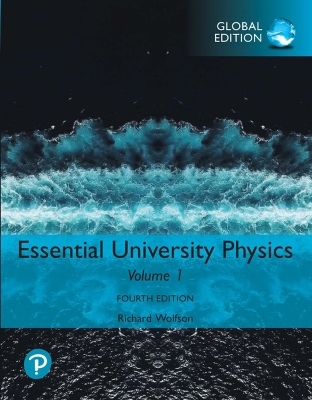
Essential University Physics: Volume 1, Global Edition
Pearson Education Limited (Verlag)
9781292350141 (ISBN)
Richard Wolfson’s Essential University Physics is a concise and progressive calculus-based physics textbook that offers clear writing, great problems, and relevant real-life applications in an affordable and streamlined text. The book teaches sound problem-solving strategies and emphasises conceptual understanding, using features such as annotated figures and step-by-step problem-solving strategies. Realising students have changed a great deal over time while the fundamentals of physics have changed very little, Wolfson makes physics relevant and alive for students by sharing the latest physics applications in a succinct and captivating style.
The 4th Edition, Global Edition, incorporates research from instructors, reviewers, and thousands of students to expand the book’s problem sets and consistent problem-solving strategy. A new problem type guides students to see patterns, make connections between problems that can be solved using similar steps, and apply those steps when working problems on homework and exams.
Volume 1 contains Chapters 1—19
Available for separate purchase is Volume 2 containing Chapters 20—39
Richard Wolfson is the Benjamin F. Wissler Professor of Physics at Middlebury College, where he has taught since 1976. He did undergraduate work at MIT and Swarthmore College, and he holds an M.S. from the University of Michigan and Ph.D. from Dartmouth. His ongoing research on the Sun's corona and climate change has taken him to sabbaticals at the National Center for Atmospheric Research in Boulder, Colorado; St. Andrews University in Scotland; and Stanford University. Rich is a committed and passionate teacher. This is reflected in his many publications for students and the general public, including the video series Einstein's Relativity and the Quantum Revolution: Modern Physics for Nonscientists, Physics in Your Life, Physics and Our Universe: How It All Works, and Understanding Modern Electronics; books Nuclear Choices: A Citizen's Guide to Nuclear Technology, Simply Einstein: Relativity Demystified, and Energy, Environment, and Climate; and articles for Scientific American and the World Book Encyclopedia.
Volume 1 contains Chapters 1—19
Volume 2 contains Chapters 20—39
1 Doing Physics
1.1 Realms of Physics
1.2 Measurements and Units
1.3 Working with Numbers
1.4 Strategies for Learning Physics
Part One
Mechanics
2 Motion in a Straight Line
2.1 Average Motion
2.2 Instantaneous Velocity
2.3 Acceleration
2.4 Constant Acceleration
2.5 The Acceleration of Gravity
2.6 When Acceleration Isn’t Constant
Chapter 3 Motion in Two and Three Dimensions
3.1 Vectors
3.2 Velocity and Acceleration Vectors
3.3 Relative Motion
3.4 Constant Acceleration
3.5 Projectile Motion
3.6 Uniform Circular Motion
4 Force and Motion
4.1 The Wrong Question
4.2 Newton’s First and Second Laws
4.3 Forces
4.4 The Force of Gravity
4.5 Using Newton’s Second Law
4.6 Newton’s Third Law
5 Using Newton’s Laws
5.1 Using Newton’s Second Law
5.2 Multiple Objects
5.3 Circular Motion
5.4 Friction
5.5 Drag Forces
6 Energy, Work, and Power
6.1 Energy
6.2 Work
6.3 Forces That Vary
6.4 Kinetic Energy
6.5 Power
7 Conservation of Energy
7.1 Conservative and Nonconservative Forces
7.2 Potential Energy
7.3 Conservation of Mechanical Energy
7.4 Nonconservative Forces
7.5 Conservation of Energy
7.6 Potential-Energy Curves
8 Gravity
8.1 Toward a Law of Gravity
8.2 Universal Gravitation
8.3 Orbital Motion
8.4 Gravitational Energy
8.5 The Gravitational Field
9 Systems of Particles
9.1 Center of Mass
9.2 Momentum
9.3 Kinetic Energy of a System
9.4 Collisions
9.5 Totally Inelastic Collisions
9.6 Elastic Collisions
10 Rotational Motion
10.1 Angular Velocity and Acceleration
10.2 Torque
10.3 Rotational Inertia and the Analog of Newton’s Law
10.4 Rotational Energy
10.5 Rolling Motion
11 Rotational Vectors and Angular Momentum
11.1 Angular Velocity and Acceleration Vectors
11.2 Torque and the Vector Cross Product
11.3 Angular Momentum
11.4 Conservation of Angular Mom
| Erscheinungsdatum | 02.07.2020 |
|---|---|
| Verlagsort | Harlow |
| Sprache | englisch |
| Themenwelt | Naturwissenschaften ► Physik / Astronomie |
| ISBN-13 | 9781292350141 / 9781292350141 |
| Zustand | Neuware |
| Informationen gemäß Produktsicherheitsverordnung (GPSR) | |
| Haben Sie eine Frage zum Produkt? |
aus dem Bereich


